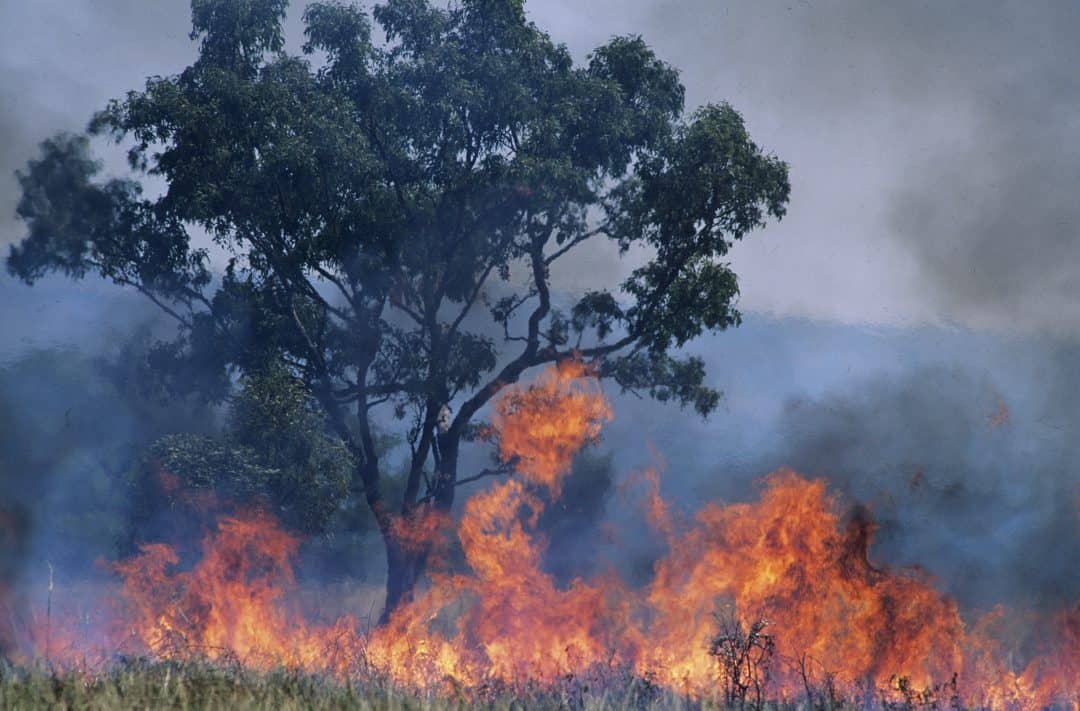Forest fires are not uncommon, they happen all the time and depending where your situated, you may or may not be more prone to these disasters.
These are horrible and can be extremely devastating. I’ve heard stories from people I know personally, about their homes and forests being burnt to the ground.
These horror stories have caused me to become extremely cautious when staying in my cabin or anywhere off-grid. In this post, I’ll be informing you on how you can keep your forest safe.
Keep your Forest Safe and Healthy
There are many ways in which you can reduce the amount of damage a wildfire causes.
Without proper forest management, a wildfire can tear through a forest, burning down everything in the vicinity.
If you contain a fire to the point where it’s only present in the upper ends of the trees, then at least you don’t lose the whole tree. You will as a result lose some canopy however that can regrow with a little bit of time. This is better than losing the whole tree and they take tens of years to regrow.
There are many ways in which you can reduce the impact of such a disaster. I’ll now provide you with some practices which you should use around your cabin to keep your forest and property safe.
Thin out your forest
The whole point of thinning out your trees is to create space between each once. Spreading out your trees is a good idea as it will be harder for fire to spread between them, therefore this will reduce the impact of a fire. Of course, you’ll still want to have trees close enough to provide you with an appealing canopy, but you want to find a good balance.
If you’re not lucky enough to have a thin forest, then you’ll have to alter it yourself manually. This involves cutting down trees yourself. This is something which you could outsources to a logging company who can professionally do the work for you. These companies can be rather pricey, so it might be in your best interest to do it yourself if you have the skills and resources. However, sometimes these companies will do it for free in exchange for the lumber they collect.
Clear out debris
You’ll want to get rid of any debris and unneeded plants such as brush and dead trees. This is all just junk which can catch and spread fire. Brushes which you can’t remove or don’t want to, should be spaced apart as if you’re thinning out your forest.
Trimming tree limbs close to the ground
Trimming tree limbs that are close to the ground are a good idea as you don’t want fire to spread towards the bottom of the tree. You’ll want to use a pole saw for this task if your scenario isn’t too bad (Don’t have many limbs to cut). I’d recommend this pole saw. This is a very effective tool and something I use a lot.
However, if you’re scenario is bit worse (You have lots of trees that need trimming) then I’d use this tool instead. This is a gas-powered chainsaw, a lot faster and effective at trimming trees than the first pole saw I recommended. It has a large reach on it, trimming up to 12 feet high. This is the best tool I’ve used for this task.
Those are the three main things you can do to contain the fire to only just the top of the trees. It also prevents fires which start on the ground from climbing up trees and devastating tree canopy.
The Defensible Space Around your Cabin
Next, I’ll be explaining how you can protect your cabin safe from wildfires which may occur. It’s often impossible to completely protect your cabin entirely, especially if your cabin is made of wood or flammable materials. Regardless I have some critical tips which you can use to reduce the impact of a fire on your property.
Within your cabins immediate surroundings, you should remove any waste or flammable materials. This includes dead trees, brushes, shrubs, and dead plants. This is for obvious reasons; you don’t want anything capable of spreading fire outside of your property. You’ll want to keep your wood pile, at least 10 feet away from your cabin as this can easily catch fire and harm your property. Items such as propane tanks should especially be kept away from your cabin.
You should ensure that you remove any flammable plants and trees for around 20 feet of your cabin. If you cannot remove a tree, then you should at least trim the branches on it to reduce the risk of it spreading fire.
If possible, you should mow and water the grass around your cabin. I’d recommend that you invest into a powerful lawn mower. I’d recommend this one. This is a very good lawn mower from a reputable brand that I highly recommend. Not only will mowing and watering your grass increase the safety of your property but it will make the area look nicer.
You should try to fill up empty space with fire resistant plants and shrubs. This is because weeds will begin to grow whether they can. Weeds are extremely flammable, burning quite easily so they’re to be avoided at every cost.
Cabin Building Materials
The materials you use when building, can greatly increase or decrease the risk of damage being caused to your property. You should always think about your safety when deciding what materials, you’ll be using when building anything. For example, wood is highly flammable compared to metal.
Firstly, I’ll be listing a few tips which can significantly reduce the chance of your deck catching fire and causing damage to your cabin.
Decks
When building a completely new deck, you should use fire resistant materials. This would be your best option, however if for some reason you must use wood then I’d recommend you purchase some fail-faced bitumen tape and place it on top of your wood.
- You should not store flammable materials under decks as hot ember may dwindle and build in-between your boards. When these embers build up, they have the potential of igniting and setting your deck on fire. Because of this, you should ensure that the space below your deck is completely empty, or at least vacant of anything flammable.
- It’s important that your deck itself is made of fire resistant materials, otherwise the deck itself could catch fire and cause damage to your property. If this is not possible, then you can place fire resistant mats on them to decrease the likely hood of a hazard.
- Despite ensuring that you don’t place any items under your decks, debris will often find its way in-between gaps and cracks. Because of this, you should make sure that you clean underneath your decks regularly. Items such as twigs and leaves are often the culprits; these items are also highly flammable as you probably already know.
Attic and Crawl Space Vents
If you have a crawl space, then you most likely have a vent on every side of your cabin, generating quality ventilation and airflow throughout your crawl space. Also, under the part of a roof that meets or overhangs the walls of your cabin should have vents, providing your home with a way of expelling air.
- When a wildfire takes places, hot embers can be blown through your vents and into your property, causing the fire to spread from the inside of you cabin. This is an unlikely even however you never want to take risks when it comes to your wellbeing. Therefore, I’ve come up with a list of things you can do to reduce the chances of this happening.
- Purchase mesh screening and install them onto your vents. This will reduce the chances of ember being able to travel through the vents by blocking and filtering them out. This will also prevent small animals from finding their way inside.
- Turbines can be purchased and installed into vents. This should blow embers and other debris out of your vents effectively. I combine this tactic with the previous tip of installing mesh as a secondary line of defense. This works effectively and should prevents the risk of this incident ever happening.
Roof Materials
Your roof itself can be a fire hazard depending on the materials it’s made of and the frequency of maintenance.
- You should get into the habit of clearing your roof and gutters every couple of months. This is because debris can be blown by the wind, onto your property. Objects like sticks and leaves are highly flammable, therefore the most often you clear them off your property – the safer you’ll be. This includes cutting all tree branches and leaves that hang over your roof.
- It’s not a good idea to build your roof from flammable materials, especially wood. Better alternatives would be concrete, clay or fiberglass reinforced asphalt shingles.
- You should maintain your roof properly, ensuring that it’s always in good condition. A worn-out or decaying roof will be more vulnerable to catching fire during a wildfire. Roofing may have to be replaced if it’s in too bad of a condition.
Chimney and Fireplace
There’s a slight risk that your chimney could cause a forest fire, therefore you should purchase and install a spark arrester. This a device which prevents the discharge of ignitable debris from combustion sources.
Another tip would be to ensure that your chimney is always clean. Chimneys are important for ventilation, allowing smoke and other dangerous toxins to leave your home. A dirty chimney can lead to a house fire.
Conclusion
You’ll never be completely safe, nature will always do what it wants however there are many ways in which you can reduce the amount of damage a wildfire causes. Without proper forest management, you’ll become a victim of nature.
It’s hard work ensuring that you take every step to keep yourself, but it is worth it. A forest fire could cost you hundreds or even thousands of dollars in repairs.
You should never put anything over your own health and safety. We all live once, and it’d be horrific to lose it because you were too lazy to put in a few hours of work.
If you’ve paid attention to all the tips I’ve given you in this post, your cabin should be safe in case of wild fire and your forest should take minimal damage.
My name is Eugene Thornhill. I'm an outdoor enthusiast who loves nothing more than being one with nature. I've lived in numerous outdoor homes and even constructed my own. Living off-grid is something I'm very familiar with, more so than living in the city. For many years I've dealt with the many problems of living off-grid. It's time to pass on my knowledge through Cabinguides.


